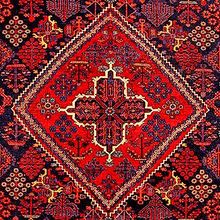Josheghan Rug
| Josheghan Rug | |
|---|---|
 Design of Josheghan Rug (Rugman) | |
| General information | |
| Name | Josheghan Rug |
| Original name | قالی جوشقان |
| Alternative name(s) | Josheghan Carpet |
| Origin | |
| Category | Village |
| Technical information | |
| Common designs | Vagireh, Geometric |
| Common colors | Crimson, Navy Blue, White, Green, Blue, Orange, Pink |
| Dyeing method | Natural, Synthetic |
| Pile material | Wool |
| Foundation material | Cotton |
| Knot type | Asymmetrical (Persian) |
Josheghan rugs originate from Josheghan, also called Maymeh, is located in north central Iran. Famous as being one of the oldest centers of continuous weaving of wool rugs in Iran, Josheghan is one of a cluster of villages that is well known for weaving wool rugs of exceptionally high quality. Tribal people in the region have been plying their trade as skilled weavers of wool rugs since the 16th century. It is not uncommon for a weaver to be totally dedicated to a single rug for months and sometimes years. This results in wool rugs of the highest quality, but very limited quantity. The local artisans weave Josheghan rugs using the asymmetrical Persian knot. Josheghan rugs are woven in both village and workshop settings, with those woven in the smaller villages considered to be of superior quality.
History
Josheghan is a city in the Isfahan Province of central Iran located near the historical city of Kashan. Josheghan was an important stop on the road between Kashan and Isfahan during the Safavid period. It was the premier village weaving large carpets without a city workshop facility. Large, gallery-size carpets woven during the late seventeenth and eighteenth centuries have beautiful colorations and designs, and can be found in museums and in the collections of wealthy consumers today.
Josheghan carpets are known in the market from the late seventeenth century. The early Josheghan designs have allover styles with semigeometric motifs. The field usually features a Lattice pattern with flowers or lozenge shapes with flowers and shrubs. By the twentieth century Josheghan weavers mostly produced a lozenge-shaped medallion style in the field. The medallions generally include a Shrub or willow tree motif. A popular design features an overall arrangement of diamond-shaped shrubs in diagonal rows, flower spray bouquets, willow trees, and plants. The main border has alternating palmettes and flower sprays with vine designs guarded by a cypress tree or leaf motif. The minor borders have flowers with leaves and vines. By the second quarter of the twentieth century Josheghan carpet designs were copied by the neighboring villages of Meymeh and Morchekhort.
Old Josheghan carpets have a brick-red background and blue or ivory border. In the twentieth century Josheghan weavers continued to use the brick-red background, but a small percentage were woven in blues or ivory. These colors are inter-changeable for the border. In addition to these colors, different shades of blue, red, green, brown, and gold are used in the design elements and outlines.
The carpets have a cotton foundation and a wool pile. The Persian (asymmetric) knot is used. Early Josheghan carpets were woven in long and narrow gallery formats that measure up to twenty-two feet in length. In the twentieth century carpets were made ranging from small sizes up to approximately twenty feet by fourteen feet. Runners measuring up to twenty feet in length can also be found in the market. Josheghan carpets and rugs are generally woven from good to very good in grade quality.
By the late twentieth century some Josheghan weavers switched from their traditional designs to make carpets and rugs similar to those of other neighboring areas to meet the demand of domestic and foreign consumers. These carpets are sold by the origin of design and color commissioned rather than the weaving location.[1]
See also
| Search for Josheghan Rug on Wikipedia. |
References
- ↑ Moheban, 2015, 268-270
Bibliography
- Abraham Levi Moheban. 2015. The Encyclopedia of Antique Carpets: Twenty-Five Centuries of Weaving. NewYork: Princeton Architectural Press.